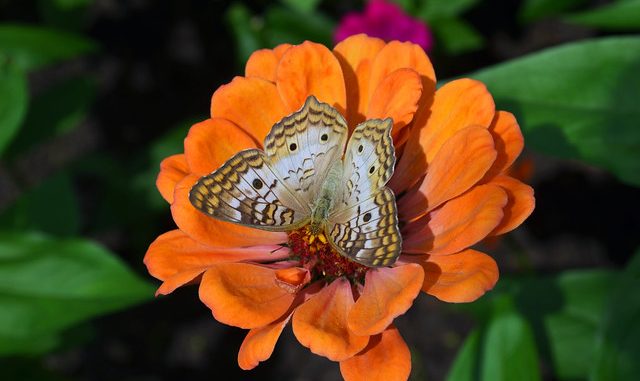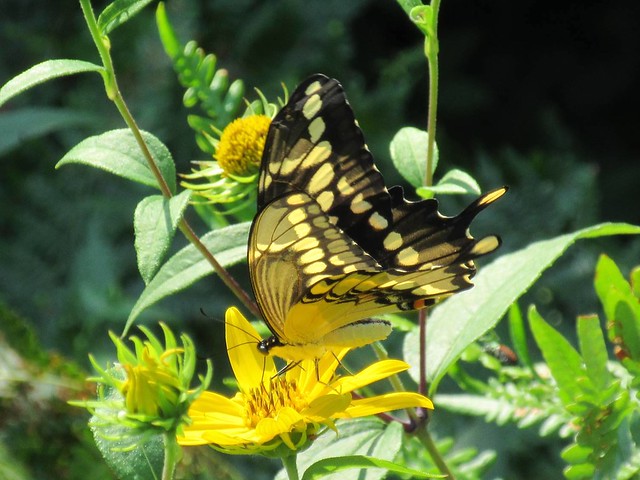
By Tina Shaw, Courtesy of U.S. Fish and Wildlife Service – Midwest Region
How to build a pollinator garden
We at the U.S. Fish and Wildlife Service know that pollinators are the engine that run healthy habitats. While we’ve been actively working to restore and conserve more than 1.3 million acres of land across the midwest, we need your help. Whether you have a few feet on your apartment balcony or several acres, you can make a difference. Follow this easy step-by-step guide to build your own pollinator garden and help ensure the future is filled with pollinators.
Planning your garden
Careful planning is essential to creating a successful pollinator garden. Follow these easy steps to make sure you have everything covered before you make your investment.
Choosing your location
While flowering plants can grow in both shady and sunny locations, consider your audience. Butterflies and other pollinators like to bask in the sun and some of their favorite wildflowers grow best in full or partial sun with some protection from the wind.
Identifying soil type and sunlight
Take a look at your soil – is it sandy and well-drained or more clay-like and wet? You can turn over a test patch or check out the soil mapper for your county to learn more. Your soil type and the amount of sunlight it gets will help determine the kinds of plants you can grow.

Choosing your plants
Research which varieties of milkweed and wildflowers are native to your area and do well in your soil and sunlight conditions. Native plants are the ideal choice, because they require less maintenance and tend to be heartier. Find a nursery that specializes in native plants near you – they’ll be familiar with plants that are meant to thrive in your part of the country. It’s essential to choose plants that have not been treated with pesticides, insecticides or neonicotinoids. You’ll also want to focus on selecting perennials to ensure your plants come back each year and don’t require a lot of maintenance.
Remember to think about more than just the summer growing season. Pollinators need nectar early in the spring, throughout the summer and even into the fall. Choosing plants that bloom at different times will help you create a bright and colorful garden that both you and pollinators will love for months!
Seeds vs. plants
Once you’ve identified your plant species, you’ll need to decide whether to use seeds or start with small plants. While both are good options, your choice will depend on your timeline and budget. Seeds are more economical, especially for larger gardens, but will require more time. If you’re using seeds, plan on dispersing them the fall or late winter ahead of your summer growing season. This gives the seeds time to germinate. Nursery-started plants cost more, but will generally give you a quick return on your investment and bring pollinators into your yard during the same growing season.
Planting your garden
When you’re ready to start planting, you’ll need your seeds or plants along with essentials like gardening tools to break the soil as well as extra soil or compost and mulch.
Prepping your garden
If you’re converting an existing lawn, you’ll need to remove grass and current plant cover and turn your soil to loosen it up. If you’re planning on using raised beds or containers, there are a lot of pre-made options available, as well as simple designs to build your own. No matter where you decide to plant your garden, you’ll want to add nutrient-rich compost or soil to improve the success of your garden.
Planting your seeds or flowers
When you’re using seeds, keep in mind that they will need time to germinate, so fall and late winter are ideal times to get started. In the fall, disperse seeds and cover with soil. In the late winter, scatter seeds over the snow. The sun will heat up the seeds and help anchor them into the snow. The melted snow provides moisture that will help the seeds germinate.
If you’re starting with small plants, make sure you follow frost guidance to avoid putting your plants in too early. Dig holes just big enough for the root system, then cover and reinforce the roots with soil or compost. Add mulch to reduce weed growth.

Wait, watch, water and weed
It may take some time, but you will eventually see butterflies and other pollinators enjoying your garden. Make sure to weed and water your garden to keep it healthy. Keep in mind that it may take a couple seasons for milkweed to start producing flowers.
The mission of the U.S. Fish and Wildlife Service is working with others to conserve, protect and enhance fish, wildlife, plants and their habitats for the continuing benefit of the American people. We are both a leader and trusted partner in fish and wildlife conservation, known for our scientific excellence, stewardship of lands and natural resources, dedicated professionals and commitment to public service.
Looking for more content? You can connect with us on Facebook, Twitter and Instagram. For multimedia, check out our videos on YouTube and download photos on Flickr.

Be the first to comment